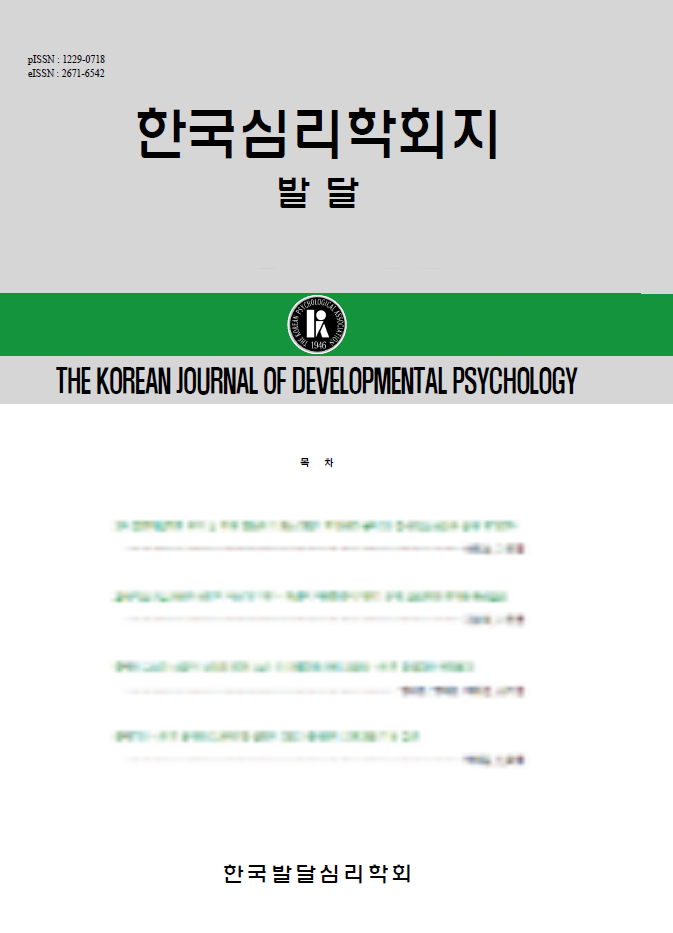open access
메뉴
open access
메뉴 ISSN : 1229-0718
ISSN : 1229-0718

The present study was designed to investigate the development of preschool children’s understanding of mixed emotions and to examine the effect of adults' verbal explanation of an emotional story on this development. Eighty children aged 4 and 6 were assigned to two different interventions (an emotion-focused explanation and an event-focused explanation) and tested before and after the intervention using mixed-emotion tasks adapted from Brown and Dunn (1996). Our results showed that the 6-year-olds outperformed the 4-year-olds, but children in both age groups had difficulty understanding mixed emotions. Most importantly, the emotion-focused explanation had a significant effect on children in both age groups: their performance was significantly increased after the emotion-focused intervention but not after the event-focused intervention. Finally, the improvement following the emotion-focused explanation was significantly higher in the 6-year-olds than in the 4-year-olds.
성소영 (2008). 유아와의 정서이야기 맥락에서 나타난 어머니의 신념. 한국아동교육학회 17(3), 111-126.
소은주 (2009). 부모의 정서사회화가 유아의 혼합정서이해에 미치는 영향. 서울대학교 대학원, 석사학위 청구논문.
송하나 (2005). 4세 아동의 정서재인, 정서 조망수용, 정서추론에서의 성차. 한국심리학회지 발달 18(4), 7-33.
유경 (2000). 아동의 혼합정서이해의 발달적 특성. 서울대학교 대학원, 석사학위청구논문.
윤혜정 (1995). 아동의 정서의 발달에 관한 연구. 숙명여자대학교 대학원 석사학위 청구논문.
Bergen, P. V., Salmon, K., Dadds, M. R., Allen, J. (2009). The effects of mother training in emotion-rich, elaborative reminiscing on children's shared recall and emotion knowledge. Journal of cognition and development. 10(3), 162-187.
Brown, J. R., Donelan-McCall, N., Dunn, J. (1996). Why Talk about Mental States? The Significance of Children's Conversations with Friends, Siblings, and Mothers. Child Development, 67(3), 836–849.
Brown, J. R., & Dunn, J. (1996). Continuities in Emotion Understanding from Three to Six Years. Child Development, 67, 789-802.
Denham, S. A., & Kochanoff, A. T. (2002). Parental Contributions to Preschoolers' Understanding of Emotion. Marriage & Family Review, 34(3), 311-343.
Donaldson, S. K. & Westerman, M. A. (1986). Development of children's understanding of ambivalence and causal theories of emotions. Developmental Psychology, 22(5), 655-662.
Dunn, J., Brown. J., Slomkowski, C., Telsa C., & Youngblade, L. (1991). Young Children's Understanding of Other People's Feelings and Beliefs: Individual Differences and Their Antecedents. Child Development, 62(6), 1352-1366.
Dunn, J., Brown, J., Beardsall, L. (1991). Family talk about feeling states and children's later understanding of others' emotions. Developmental Psychology, 27(3), 448-455.
Fivush, R. (2007). Maternal Reminiscing Style and Children’s Developing Understanding of Self and Emotion. Clinical Social Work Journal, 35(1), 37-46.
Harter, S. (1977). A cognitive developmental approach t o children's expression of conflicting feelings and a technique to facilitate such expression in play therapy. Journal of Consulting and Clinical Psychology, 45(3), 417-432.
Harris, P. L. (1983). Children's understanding of the link between situation and emotion. Journal of Experimental Child Psychology, 36(3), 490-509.
Harris, P. L. (1999). Individual differences in understanding emotion: The role of attachment status and psychological discourse. Attachment & Human Development, 1(3), pp. 307-324.
Harris, P. L., Guz, G. R., Lipian, M. S., Man-Shu, Z. (1985). Insight into the Time Course of Emotion among Western and Chinese Children. Child Development, 56(4), 972-988.
Harter, S., & Whitesell, N. R. (1989). Saarni, Carolyn (Ed); Harris, Paul L. (Ed), Children's understanding of emotion. Cambridge studies in social and emotional development., (pp. 81-116). New York, NY, US: Cambridge University Press.
Harter, S., Buddin, B. J. (1987). Children's understanding of the simultaneity of two emotions: A five-stage developmental acquisition sequence. Developmental Psychology, 23(3), 388-399.
Ilaria, G. & Veronica, O. (2011). Emotional state talk and emotion understanding: a training study with preschool children, Journal of Child Language, 38(5), 1124-1139.
Kestenbaum, R., Gelman, S. A. (1995) Preschool Children's Identification and understanding of mixed emotions. Cognitive Development, 10, 443-458.
Laible, D., & Song, J. (2006). Constructing Emotional and Relational Understanding : The Role of Affect and Mother-child Discourse. Merrill-Palmer Quarterly, 52, 44-69.
McElwain, N. L., Halberstadt, A. G., Volling, B. L. (2007). Mother- and Father-Reported Reactions to Children’s Negative Emotions: Relations to Young Children’s Emotional Understanding and Friendship Quality. Child Development, 78(5) 1407-1425.
Peng, M., Johnson, C., Pollock J., Glasspool, R., & Harris, P. L. (1992). Training young children to acknowledge mixed emotions. Cognition & Emotion, 6, 387-401.
Pons, F., Harris, P. L., Doudin, P. A. (2002). Teaching emotion understanding. European Journal of Psychology of Education. 17(3), 293-304.
Pons, F., & Harris, P. (2005). Longitudinal change and longitudinal stability of individual differences in children's emotion understanding. Cognition & Emotion. 19(8), 1158-1174.
Tenenbaum, H. R., Alfieri, L., Brooks P. J., Dunne, G. (2008). The effects of explanatory conversations on children's emotion understanding. British Journal of Developmental Psychology, 26(2), 249-263.
Wellman, H. M., & Lagattuta, K. H. (2004). Theory of mind for learning and teaching: the nature and role of explanation. Cognitive Development, 19(4), 479-497.
Wintre, M. G., Vallance, D. D. (1994). A developmental sequence in the comprehension of emotions: Intensity, multiple emotions, and valence. Developmental Psychology, 30(4), 509-514.
Zhou, Q., Eisenberg, N., Losoya, S. H., Fabes, R. A., Reiser, M., Guthrie, I. K., Murphy, B. C., Cumberland, A. J., (2002). The Relations of Parental Warmth and Positive Expressiveness to Children's Empathy-Related Responding and Social Functioning: A Longitudinal Study. Child Development, 73(3), 893-915.
